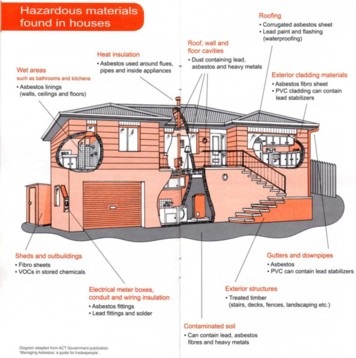Hazardous Materials Found in Houses
Some of the hazardous materials that can be found in a building's structure include:
- Lead in the form of domestic lead paint, damp coursing, flashig (waterproofing), solder, tap fittings and water pipes.
- Asbestos most commonly as flat or corrugated sheets ('fibro') for walls, ceilings and roofing. Other products include water and drainage pipes, electrical conduit and guttering.
- Treated timber (contains chemicals to prevent rot and insect attack) used in a variety of structural applications, landscaping, decking and in wet environments such as bathroom or kitchens.
- Volatile organic compound (VOCs) are organic chemicals that are used in paints, varnishes, glues, cleaning products, paint thinners, fuels and manufactured timber. Their fumes (or vapours) can be toxic. All paint products contain many different chemicals.
Materials in and Around the House
Dust contaminated with lead, arsenic and other heavy metals can accumulate in ceilings, wall and floor spaces and in soil. Sources include pest renovations, exhaust fumes and industrial pollution. The dust can be hazardous if disturbed.
Repeated past treatments with pesticides in and around buildings can contaminate large areas. Older pesticides such as organochlorines that may have built up over time can be hazardous if disturbed.
Materials Used During Renovations
VOCs are found in paints, varnishes, glues, paint thinners and other products. They are easily inhaled as fumes. Dust particles from construction materials such as cement, plaster, adhesives, fibreglass insulation, wood (sawdust) and fillers (eg. 'builders bog') can also be hazardous.
